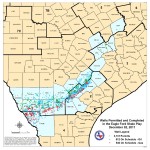Like Working in a Refinery: Fracking’s New Chemical Hazards for Workers

Courtesy NIOSH
Sandstorm: dust rises during off-loading at drilling site
Federal workplace watchdogs are warning that the boom in “fracking” is now exposing oilfield workers to hazards they can inhale. It’s an additonal risk for roughnecks and service company crews working in an industry that already has a much-higher-than average injury rate.
A “Hazard Alert” from government agencies OSHA and NIOSH has the industry scrambling for fixes.
“We’re working really hard to help engineer-out the hazard and protect these workers,” Rick Ingram told StateImpact. Ingram works for oil giant BP, coordinating rig safety programs with government regulators.
“We’re getting the word out any way we can about this potential hazard. This hazard alert has really helped us do that, it’s helping bring attention to it,” said Ingram.
Dangerous Dust

Dave Fehling/StateImpact Texas
Rail cars bring tons of sand to Gonzales County
The Hazard Alert was for one threat in particular: silica, the chemical component in sand. Each well that’s “fracked” uses tons of sand that’s shot down the hole at high pressure, fracturing the shale rock formations thousands of feet underground. The sand particles act as tiny wedges, holding the rocks open, allowing natural gas and oil to escape.
So much sand is now being used in Gonzales County, 75 miles east of San Antonio—the heart of the mineral-rich Eagle Ford Shale—that a freight train company has built a new rail yard. On the site are enormous silos for sand operated by oilfield service companies including Halliburton. Trucks haul the sand to drill sites in Gonzales and neighboring counties. But as it’s off-loaded from those trucks, federal workplace investigators say the sand can create dangerous amounts of dust.
Over 10 Times Limit in Texas
In air samples taken at a drill site in the Eagle Ford Shale late last summer, investigators found silica dust levels exceeding government safety standards in half of the eight samples taken. In one sample, silica levels were over 10 times the safe limit which meant that even if workers wore air-purifying half-masks, they still would be in danger according to NIOSH. Similar and sometimes worse levels were found at sites in other fracking hotspots in Pennsylvania, Colorado and Arkansas. In fact, NIOSH says silica dust levels exceeded government safety standards at every fracking site they tested.
Breathing silica dust can cause silicosis, an incurable lung disease, and increases the risk of lung cancer.

Dave Fehling/StateImpact Texas
Robert Emery says past drilling booms also led to rise in health hazards
“Short term exposure at a high enough level can result in permanent damage,” said Robert Emery, a chemical safety expert with the University of Texas Health Science Center at Houston.
Emery points to a problem that occurred the last time there was a boom in drilling: radiation. Technicians use industrial x-ray machines to check the welds in pipes. During the boom of the 1980’s, inspectors found workers were being exposed to dangerous levels of radiation from the x-rays. Emery says new regulations were put in place in Texas, resulting in almost no over-exposures today.
“That’s a great success story. But in its place now, a different hazard has come up,” said Emery.
Silica Not Only Toxic Hazard
Silica was actually just one of several fracking chemicals (silica is silicon dioxide) that NIOSH said can pose hazards at well sites. There are “biocides”like chlorine used to kill slime in hydraulic lines. There are fumes from the hydrochloric acid used to clean cement out of the lines. There’s exhaust from diesel trucks and generators.

Dave Fehling/StateImpact Texas
Robert Colin in the booming Eagle Ford Shale region of South Texas: "It feels like we're working in a refinery"
And there’s hydrogen sulfide gas. The heavier-than-air gas can be deadly and it’s why workers wear what look like yellow pagers.
“It’s an H2 monitor,” explained Robert Colin, an oilfield worker who paints tanks that hold crude oil.
“It’ll start beeping if the level gets to high,” Colin told StateImpact.
He wears the sensor on the chest pocket of his coveralls. Its placement is no accident.

Sensor for hydrogen sulfide gas
“It’s gotta be worn down here. Some guys wear it on their hard hat but once the fumes get up to your head, you’re gone.”
With the sensors, evacuation plans, and concern over what workers are breathing, Colin says “it feels like we’re working in a refinery.”
The pocket sensors are a way to protect workers from chemical vapors. But what about the danger from the silica dust? There are no pocket sensors for that and NIOSH says it won’t be as simple as providing respirator face masks.
“Given the magnitude of silica-containing, respirable dust exposures measured by NIOSH, personal respiratory protection alone is not sufficient to adequately protect against workplace exposures,” said the NIOSH scientists in a report.

Courtesy NIOSH
NIOSH conception of modifications to minimize dust
Instead, NIOSH and the oil and gas industry are working on modifications to the equipment that moves sand from rail cars to trucks and finally to tanks at the well site. Covering up access ports, using augers to move sand instead of conveyor belts, and something as simple as watering down roads where the fine sand has spilled might reduce the dust inhaled by workers.
NIOSH said respirators should be provided as well to workers if the modifications don’t reduce dust levels to acceptable levels. The agency is also recommending that companies do medical monitoring of workers including lung exams and chest x-rays.
